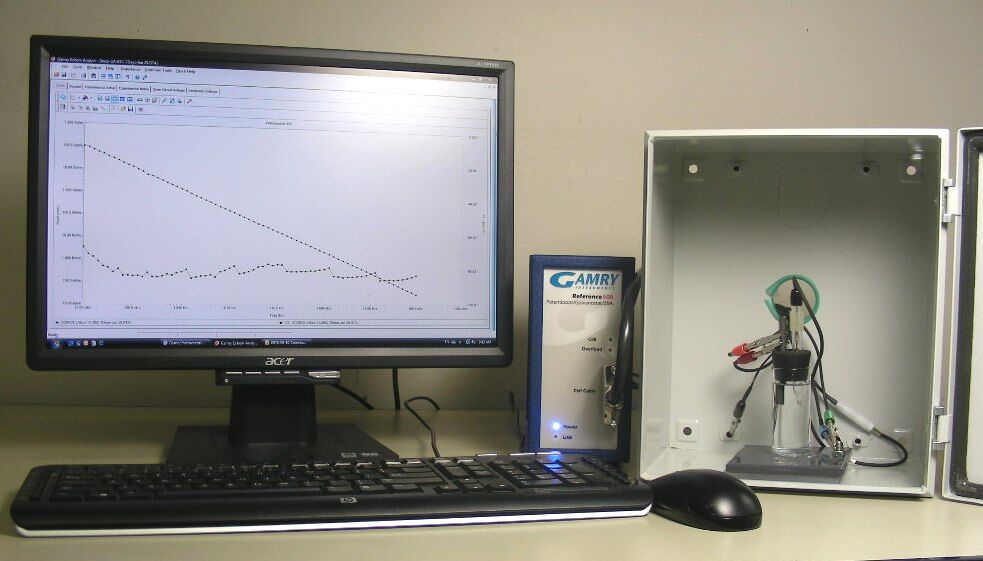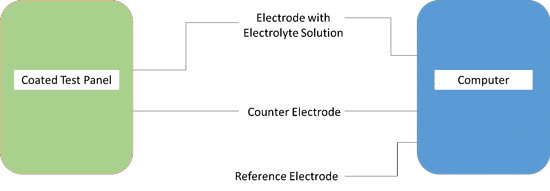
 EIS testing apparatus. Photo courtesy of Amal Al-Borno, Charter Coating Service (2000), Ltd.
EIS testing apparatus. Photo courtesy of Amal Al-Borno, Charter Coating Service (2000), Ltd.
A new generation of high-temperature fusion-bonded epoxy (FBE) coatings are being developed as a lower-cost alternative to alloy steels for protecting the internal surface of tubing, casing, flowlines, and pipelines. In the new FBE coatings with a high glass-transition temperature (Tg), the highly functional epoxy resin and ingredients can make interpretation of testing results difficult for coating specifiers.
According to NACE International member Dustin Traylor, global functional product manager/technical services manager with Axalta Coating Systems (Houston, Texas, USA), tests for internal FBE coatings are very different than tests designed for external pipe FBE coatings because of the nature of the exposure environment for internal pipe coatings (e.g., temperature, pressure, gas, and chemical contaminants). To simulate these field conditions in a controlled laboratory setting and accelerate the evaluation process, coating scientists use an autoclave test.
During this type of test, coating samples are exposed to liquids and gases under high temperature and pressure inside a specially designed metal vessel. The conditions of the autoclave test are typically selected to simulate the potential upper limits of service to facilitate any degradation of the coating. Coatings that demonstrate the least reaction to the environment are considered the most suitable.
Autoclave testing is widely accepted as the most effective laboratory test for evaluating the performance of internal pipe coatings, Traylor says; however, he notes there are major differences within the coatings community on the length of testing time utilized to observe a coating’s reaction to the environment, as well as the interpretation of the results gathered at the test’s conclusion. Typically, laboratories will compare swelling, blistering, adhesion, and color change of exposed coating samples to a sample that is unexposed.
Although the parameters of an autoclave test should be determined based on field conditions and will vary depending on the application, the coating exposure time in an autoclave environment could be standardized. Table 1 lists the average price of an autoclave test performed at various time intervals.

Recently, Traylor notes, specifiers have started to require longer autoclave tests as part of the approval process, with some engineers requiring exposures as long as 60 days. Because specifiers must judge a coating’s life expectancy based on the results, he says, the theory is that longer autoclave exposures should produce more reliable results. The tendency to require longer autoclave tests is not without merit, he adds; coatings are used to protect expensive piping assets. The issue is exacerbated, however, by the wave of newer technology resins that may allow a coating to survive an autoclave environment of a certain length of time with no visible signs of failure and good performance in post-exposure testing.
This is particularly true of lower Tg coatings exposed to higher autoclave temperatures, he says. The Tg is the temperature where a polymer (coating) changes from a hard and relatively brittle solid state to a viscous or rubbery condition. At or above this temperature, the permeation rate of oxygen, moisture, and other ionic substances increases considerably, which may lead to rupture of the polymer structure and ultimately failure of the coating system. Although the coating’s molecular structure is compromised when exposed to temperatures above its Tg, there may not be sufficient time and pressure during the test to produce a blistering failure.
Traylor comments that electrochemical impedance spectroscopy (EIS) is quickly gaining recognition as a fast, cost-effective tool for evaluating a coating’s ability to withstand exposure to a specific environment, and allows specifiers to determine if the coating can be expected to survive in a particular service environment for the entire design life of the asset (five to seven years or longer).
Organic coatings provide corrosion protection by isolating the corrosive environment from the steel structure to which they are applied. In general, Traylor says, a coating needs to have good barrier properties to provide good protection. Low permeability to water, ions, gases, and other corrosives is essential to the success of a coating system at higher temperatures. He explains that field experience and laboratory research have shown that highly protective coatings with good barrier properties have a high electrical resistance.
EIS is now a well-established laboratory technique for evaluating the corrosion protection of organic coatings. By testing the coating’s impedance, Traylor adds, EIS can simultaneously measure coating degradation caused by exposure to an electrolyte as well as the change in the corrosion rate of the substrate caused by coating perforation. Impedance (alternating current [AC]) is calculated the same way as resistance (direct current); however, impedance also includes reactance, which is a measure of the type of opposition to AC electricity due to capacitance or inductance. According to Ohm’s Law: R=V/I, where R= resistance, I= current flow, and V= voltage, the impedance changes at distinct frequencies.
A three-electrode arrangement that includes a working electrode, reference electrode,and counter electrode is used to perform EIS in aqueous solutions. During the EIS test, an AC voltage of varying frequencies is applied to the coating sample through an electrode submerged in an electrolyte. This allows information about a coating’s resistance to electrochemical reactions to be collected and evaluated.

According to Traylor, the impedance of the coating will change during the experiment as a result of water swelling or absorption, which is why the application of EIS as a tool for evaluating coating life span is theorized to be so effective. The corrosion protection from a coating, expressed in terms of Log Z, increases as its impedance increases. Therefore, a newly applied, high-performance coating will have high impedance in the range of a Log Z value of 9 to 11.
While there is no consensus on utilizing EIS for making decisions on internal pipe coating service life, Traylor notes that coatings experts are continually working to perfect the application of this technique. He mentions several suggestions for including this technology in a coating specification. One is to use EIS in conjunction with accelerated weathering (in an autoclave) to speed up the decision-making process. While there is no agreed-upon duration for exposing a coating sample to an autoclave environment, 96-h and 7-d tests have yielded results that support a change in EIS occurring within that time span.
Measuring impedance prior to exposure to obtain a baseline is another suggestion. Because it is impossible to replace the electrode in the exact place after exposure, it is good practice to develop a range using three or more measurements. After exposure, one test per phase should suffice. Another recommendation is to measure the impedance of the sample for each exposure phase (water, hydrocarbon, and gas). The advantage of a static autoclave test is that the coating’s resistance to each phase can be easily evaluated. This information can be used to make future decisions for coatings in similar environments. Additionally, he suggests comparing the results of pre- and post-exposure testing to determine loss of barrier properties. Post-exposure Log Z values should be at least 90% of the baseline range.
Lastly, Traylor proposes using a holistic approach. An effective specification should require use of EIS data inclusively with other tests (e.g., blistering, swelling, softening, intracoat foaming, undercreep/metal attack, interface of phases, color change, and adhesion) to determine a coating’s fitness for service.
To accomplish the goal of developing a standard for evaluating autoclave results for internal pipe coatings using EIS, Traylor comments that participation of the entire industry (specifiers, owners, applicators, and coating manufacturers) is required. The exchange of field information and tracked performance of coatings in high-temperature/high-pressure environments is critical. Detailed analysis of the coating’s exposure environment before installation and periodically during service is also valuable information that can be used by specifiers to develop realistic expectations of design life.
He also recommends that inspectors certified by NACE and SSPC: The Coatings Society evaluate coatings after service and send reports to the coating manufacturer for archival. Applicators should also record details of the application procedure. If a foundation of information is laid, he concludes, the entire industry will benefit from faster, less expensive coating testing.
Source: Dustin Traylor, Axalta Coating Systems—email: dustin.traylor@axaltacs.com.

Recent Comments